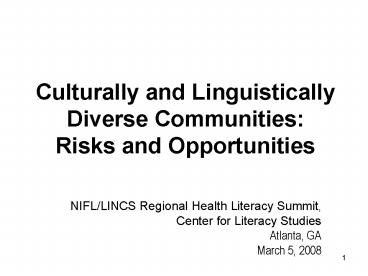Culturally and Linguistically Diverse Communities: Risks and Opportunities - PowerPoint PPT Presentation
1 / 20
Title:
Culturally and Linguistically Diverse Communities: Risks and Opportunities
Description:
Practical, affordable solutions that eliminate language barriers and increase ... The politics and policies of the U.S. health industry and workplaces with ... – PowerPoint PPT presentation
Number of Views:25
Avg rating:3.0/5.0
Title: Culturally and Linguistically Diverse Communities: Risks and Opportunities
1
Culturally and LinguisticallyDiverse
Communities Risks and Opportunities
- NIFL/LINCS Regional Health Literacy Summit,
- Center for Literacy Studies
- Atlanta, GA
- March 5, 2008
2
Faculty Presenter Disclosure
- No discussion of any drugs or medical devices
- No financial arrangement or other relationship
with manufacturers of any commercial products
3
Hablamos Juntos
- Practical, affordable solutions that eliminate
language barriers and increase quality of care
for Latino patients - Increase availability of language
services/interpreters - Useful health-related materials
- Easy to use signage
4
Presentation Objectives
- Explore risk associated with culture and language
differences in patient-provider communication - Describe promising practices for overcoming
language barriers to provide patient-centered
care - Offer thoughts on health system level
opportunities
5
Why culture and language matter
- National Demographic Trends
- 91 ratio person (1950)
- 1.51 ratio under age 40 (2000)
- Today, nearly 50 of children under age 5 are
children of color - The portion of the U.S. population that speaks a
language other than English increased more than 7
million, in 5 years bringing the total to 52
million, while the limited English speaking
population increased by almost 4 million, to a
total of 23 million (2005)
6
California the bellwether state
- 1 of 4 Majority-minority states
- Nearly 1 in 3 (27.2) are foreign born
- 1 in 5 (20.2) report speaking English less than
"very well" considered limited English proficient
(LEP) (2006 American Community Survey)
7
Yes Doctor lo que diga
Henry Ford Hospital 1932 Frida Kahlo
8
Implications for clinical care
- Comprehension and behavior is influenced by
cultural values and beliefs - Language differences go beyond vocabulary and
require more than interpreters - Health literacy barriers include limited health
knowledge and lack of familiarity with human
anatomy
9
Institute of Medicine Report
- Health Literacy A Prescription to End Confusion
(2006) - Ability to obtain, process, and understand
basic health information and services needed to
make appropriate decisions - Confusion more likely in unfamiliar contexts
- A reflection of both the patient and the health
care system (professional skills and processes)
10
Communication a cornerstone of patient safety
- Communication problems are the leading root cause
of accidental patient deaths and serious injuries
among all patients reported by hospitals over the
last decade (JCAHO 2005) - Ineffective communications place patients at
greater risk of preventable adverse events
11
Communication Challenges
- Beyond language differences, the language we
speak in health care is often not plain English - Studies show the skills required to understand
and use health care-related communications exceed
the abilities of the average person Health
Literacy A Prescription to End Confusion (2006) - Disparities in health status/heath outcomes more
frequent in populations with language barriers
12
Opportunities for patient-centered care with
diverse patient populations
13
Multilevel strategies are needed
- Building skills among patients, providers and
health workforce in general - Adapting health care systems and practices to
enable personalize health care delivery - Using incentives and rewards (e.g. pay for
performance) - Increasing public awareness and common vision
about our multilingual, multicultural world
14
Process of inquiry
- Culture is a product of lived experiences, it is
important to understand the individual in context
- Health care is personal one reason why every
health care encounter is a cross cultural
experience - Seek to discover - Communication approaches and
strategies that emphasize the interaction
process. Goal is Cross cultural efficacy with
less emphasis on cultures per se (Ana Nunez 2000)
15
Communication-based Approaches
- BATHE Model (psychological social context)
- CRASH Model (foundational values)
- ESFT Model (patients explanatory model)
- ETHNIC Model (patients explanatory model)
- Kleinmans Nine Questions
- LEARN Model (communication model)
16
Communication Techniques
- Use plain language
- Use teach back and show back techniques to
assess and ensure patient understanding - Limit information provided to two or three
important points at a time - Use drawings, models or devices to demonstrate
points - Encourage patients to ask questions
- Employ a universal precautions approach to all
patient encounters by using clear communications
and plain language, and probing for understanding
17
The significant problems we have cannot be solved
at the same level of thinking with which we
created them. Albert Enstein
18
Mission, vision and values
- The politics and policies of the U.S. health
industry and workplaces with systems, policies
and practices great influenced by
licensing/accreditation and revenue seeking
strategies - Change requires missions that embrace diverse
populations, visions of accommodation and
flexibility and values that place the patient
first
19
Growing multilingual capacity its about time
- US is the only developed country that is not
growing multilingual capacity 3/4th of the
world population is multilingual - English as a Second language is an important
investment - Early language learning and basic health content
can be twin goals
20
Thank youFor more information...Yolanda
Partida, MSW, DPA, DirectorHablamos Juntos,
National Program OfficeUCSF Fresno Center for
Medical Education Research yolanda_at_hablamosjun
tos.org
www.hablamosjuntos.org or www.wespeaktogether.org

